Right off the Muslim Street lies the palace complex of a Ming dynasty nobleman, Gao Yue Song, who rose to greatness 400 years ago by placing second in the Confucian imperial examination; a wall plaque at the house celebrates his brilliance as a 12-year-old test taker. We wandered through the tranquil, rambling house, presented as a “scholar’s residence,” with its succession of rooms and courtyards.
刚一出清真美食街就是明代高官高岳崧的宅邸,400年前高岳崧在科举考试的殿试中夺得榜眼,后荣升高位。宅邸中的一面墙匾上赞美他聪颖过人,年仅12岁就参加考试。我们在安静、庞大的宅邸中漫步。这座宅邸被称为“学者宅邸”,有无数房间和一重重院落。
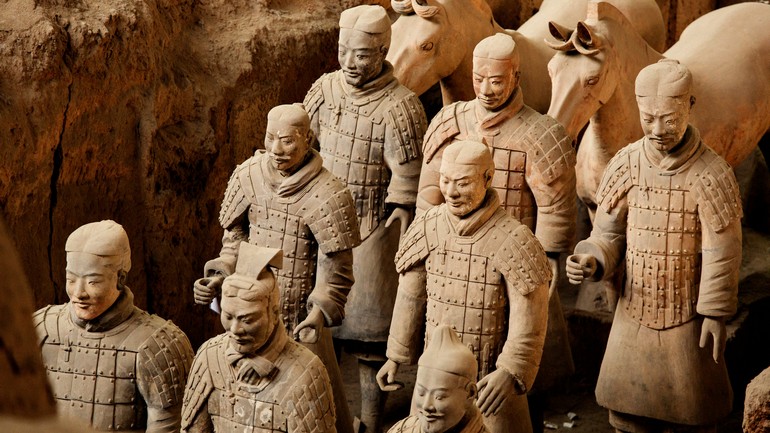
The next day, it was time for Xian’s main attraction: the terra-cotta warriors. An hourlong bus ride took us into the countryside, past universities and spas; the area is famous for its natural beauty and healing springs. The Museum of Qin Terra-Cotta Warriors and Horses is laid out as a series of huge buildings, reminiscent of airplane hangars, that extend over the three main trenches where the warriors were excavated after they were discovered in 1974. Pit 1 features thousands of the life-size clay warriors lined up in rows, while Pit 2 has a smaller group, including chariots and horses. In the Pit 3 building, you can get close to individual warriors in glass cases. The museum is, without question, a strange and wonderful place to visit, whether you prefer to reflect upon the vanity of emperors, the skill of the terra-cotta manufacturers — who managed to give the soldiers distinctive personalities — or upon the lives and longings of the peons who fought the imperial wars.
第二天我们去参观西安的主要景点:兵马俑。巴士行驶一小时后我们来到乡间,经过了很多大学和温泉浴场。这个地区以天然美景和能治愈疾病的温泉闻名。秦始皇兵马俑博物馆由一系列巨大的建筑组成,让人想起了飞机棚,它们覆盖着三个主要的战壕,1974年兵马俑就是在这里被发现后挖掘出来的。1号坑里有上万个真人大小的兵俑,他们一排排站立在那里;2号坑的规模较小,有战车和战马。在3号坑里,你可以近距离观察放在玻璃柜中的单个兵俑。这个博物馆无疑是个值得参观的奇妙的地方,你可以在这里回想皇帝们的虚荣、兵马俑制作者的技艺——他们让每个士兵都具有独特的个性,或者参加帝王战争的士兵们的生活与渴望。
The next day, we had breakfast in the nameless food alley across from our hotel, where one particularly enterprising vendor with a grill built on to a bicycle cart made grilled chicken sandwiches topped with a fried egg and served on buns of puffy white Chinese bread slathered with two kinds of spicy bean sauce.
次日,我们在酒店对面的无名美食街上吃了早餐。一个特别有上进心的摊贩在三轮车上安了一个烤架,制作烤鸡三明治——烤鸡上面放个煎蛋,夹在蓬松的白饼中间,厚厚地涂上两种辣豆瓣酱。
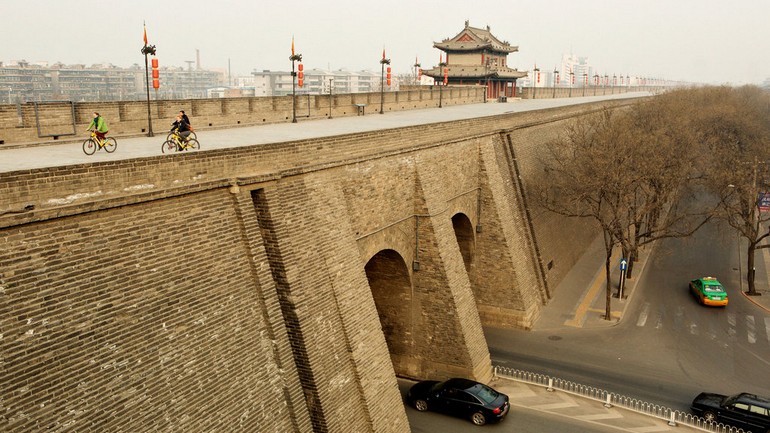
Then we went in search of an entrance that would take us up on the Xian city walls. Soon we found ourselves wandering through a part of the old city that is lined with stores and stalls selling calligraphy supplies: inks, ink pots, brushes and seals. On the walls, we walked along a piece of the old city circumference, from guardhouse to guardhouse, passing bicycle rental facilities, where more ambitious visitors can circumnavigate the eight-mile distance on two wheels.
然后我们出发寻找登上西安城墙的入口。我们很快发现自己漫游在古城的一个区域,这里街道两边的店铺和摊铺出售书法用具:墨水、墨水瓶、毛笔和印章。我们在城墙上走过圆形古城的一段,经过了几个哨岗和自行车出租点,更有雄心的游客可以骑车绕八英里长的城墙转一圈。
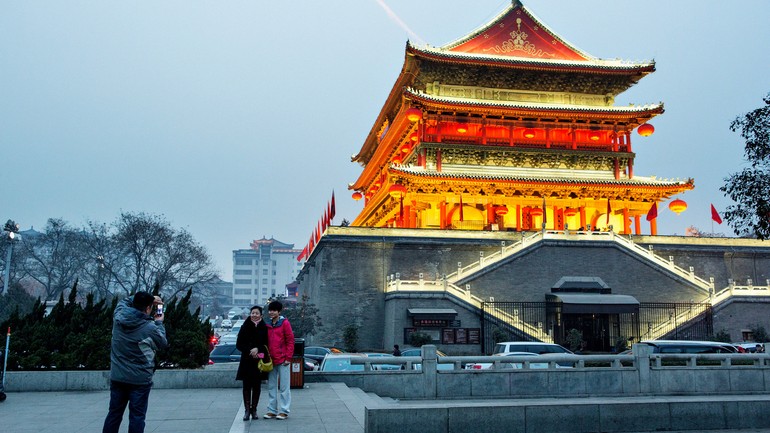
Later, we took a taxi to the Big Wild Goose Pagoda, a Buddhist temple dating to A.D. 652. The pagoda is surrounded by pavilions with stone carvings, many of them celebrating the journeys of the scholar Xuanzang, a seventh-century Buddhist monk who traveled all over China and then on to India, in search of wisdom and sacred Buddhist texts, which the pagoda was originally built to house. We climbed the interior stairs, up the seven levels, and looked out over the modern city of Xian.
然后我们打车去了大雁塔,这座佛教寺庙始建于652年。佛塔周围有很多亭子,亭子上的石雕大多是在赞美高僧玄奘的旅行。这位七世纪的和尚在中国游遍了中国,然后去了印度,寻找智慧和佛经。这座佛塔最初就是为了存放那些佛经而建的。我们沿着里面的楼梯爬到七层,向外张望西安这座现代城市。
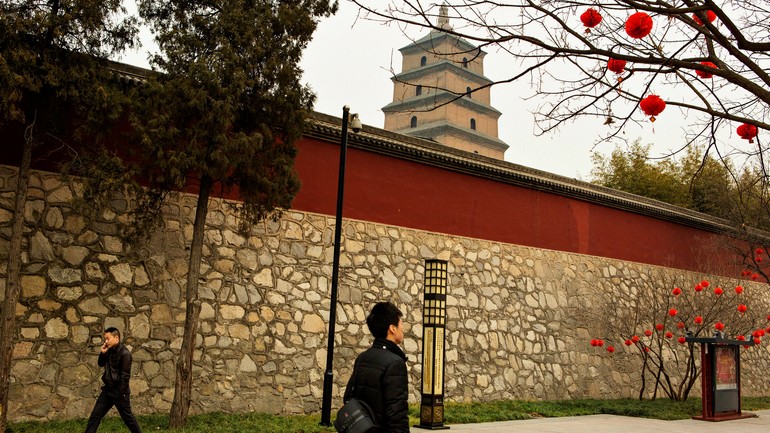
On our last day, we visited the Hanyangling tombs, another lavish imperial burial site, this one from the Han dynasty emperor Liu Qi, who reigned from 156 to 141 B.C., and his Empress Wang. This emperor was again buried with terra-cotta figurines — but they were very different, both in scale and in scope, from the infantry, archers, officers and charioteers who make up the more famous terra-cotta army. For one thing, the figures at the Hanyangling tombs are doll-size, and include serried ranks of miniature sheep and goats and cows and pigs, presumably sent into the afterlife as a food source. In the enormous underground museum, you peer into the dim tomb compartments at groups of human figures or alternatively, at underground herds of livestock.
最后一天,我们参观了另一个奢华的皇家陵墓——汉阳陵。它是汉代皇帝刘启和王皇后的陵墓。刘启在位的时间是公元前156年至公元前141年。陵墓中也有兵马俑,但是从规模到范围,这里的兵马俑都与组成那个更著名的兵马俑军队的步兵、弓箭手、军官和车夫很不一样。首先,汉阳陵的兵马俑要小得多,还密密麻麻地排列了很多小型绵羊俑、山羊俑、牛俑和猪俑,可能是送往阴间做食物来源。在巨大的地下博物馆里,你向昏暗的墓室望去,能看到成群的人体雕像或牲畜雕像。
The emperor’s insistence on eating well underground (he was buried with figurines representing cooks and servants as well as all that meat on the hoof) is well reflected in the food offerings of Xian. We had dinner one night at Tong Sheng, a restaurant devoted to a higher-end version of paomo, and another night at the Xian Hotel, in a vast dining room of somewhat tattered elegance. But the most interesting food is bought — and eaten — outside. Skewers of highly spiced lamb; cold, sour liang ping noodles; ground meat sandwiches, sweet potato fritters; hand-pulled Xian noodles with chile sauce and cilantro; steamed sticky rice on skewers with sweet sauce and peanuts, mutton soup dumplings. There were also nuts and dried fruit; the Muslim Street, in particular, featured store after store with machines sorting walnuts by size, with arrays of dates arranged by value, and vivid orange persimmons available by the box.
这位皇帝对在阴间享受美食的坚持(他的陵墓有些雕像代表厨师、仆人和所有未屠宰的牲畜)在西安丰富的美食中得到了充分体现。有一天晚上我们在同盛斋用餐,这家餐馆专做高档泡馍。还有一天晚上我们去了西安饭店,那里巨大的餐厅有种破旧的优雅。但是最有趣的食物是在户外购买和食用的。特别辣的羊肉串;又凉又酸的凉皮;肉夹馍;红薯煎饼;带有辣酱和香菜的拉面;串在竹签上的含有甜酱和花生的蒸糯米;羊汤饺子。还有各种坚果和干果。特别是在清真美食街上,一家家特产商店用机器按个头挑选核桃,一排排大枣按价格摆放,箱子里放着很多鲜艳的橙色的柿子。
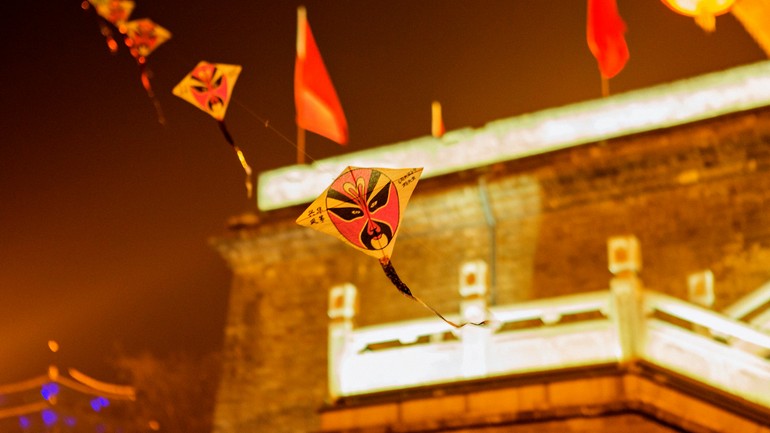
On our last morning, when we went out to buy our breakfast sandwiches from the man with the grill on his bicycle cart, he handed me my sandwich and said, “Tomorrow?”
最后一天早上,我们去那个在三轮车上安烤架的人那里买早餐三明治时,他把三明治递到我手里说:“明天还来吗?”
In fact, I could have wished for another couple of days in Xian; there was still so much more to explore in this city that deserves to be more fully seen and tasted.
实际上,我真希望能在西安多待几天。这座城市还有很多东西值得探索,值得更仔细地观看和品尝。



 闽公网安备 35020302035673号
闽公网安备 35020302035673号
0 responses on "Feasts for the Eyes, and the Palate in Xian, China-Part 2"